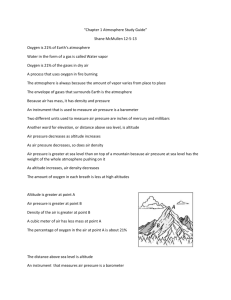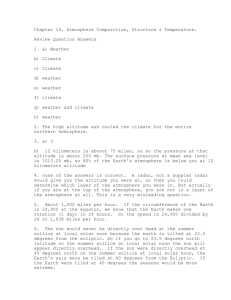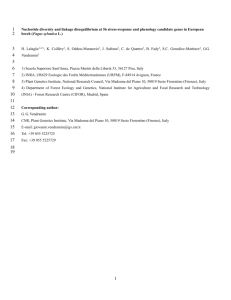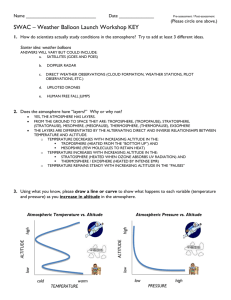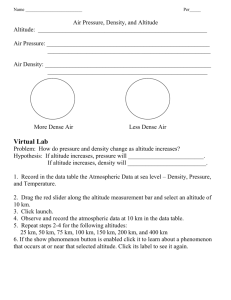MAE 1202 Lab Hmk 1
advertisement
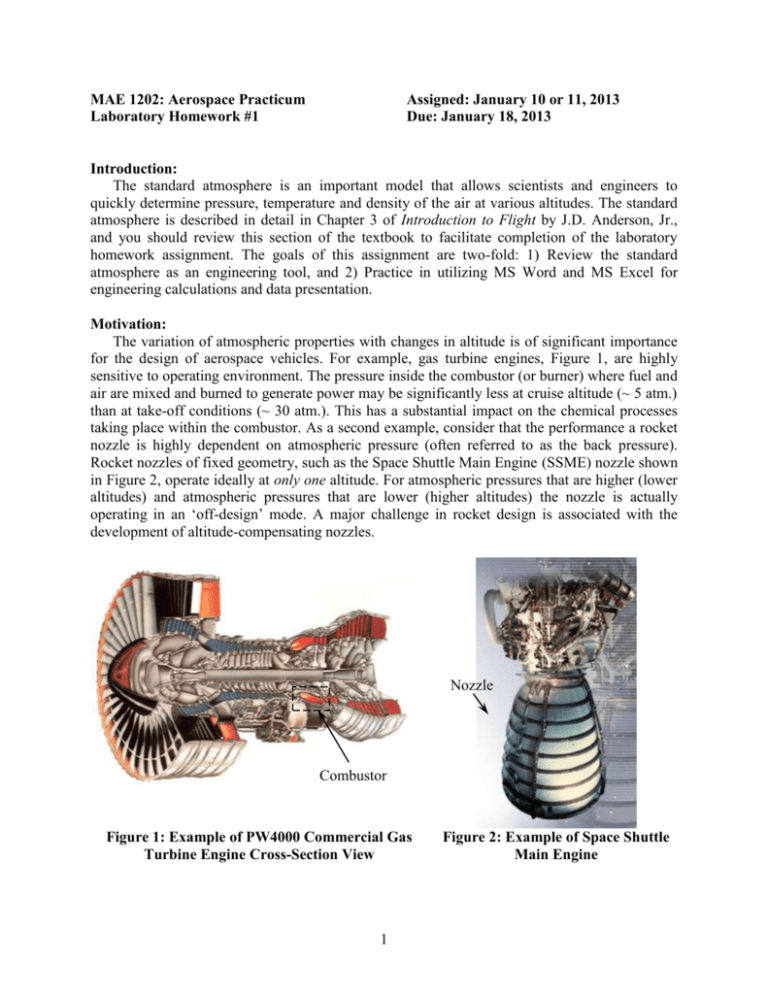
MAE 1202: Aerospace Practicum Laboratory Homework #1 Assigned: January 10 or 11, 2013 Due: January 18, 2013 Introduction: The standard atmosphere is an important model that allows scientists and engineers to quickly determine pressure, temperature and density of the air at various altitudes. The standard atmosphere is described in detail in Chapter 3 of Introduction to Flight by J.D. Anderson, Jr., and you should review this section of the textbook to facilitate completion of the laboratory homework assignment. The goals of this assignment are two-fold: 1) Review the standard atmosphere as an engineering tool, and 2) Practice in utilizing MS Word and MS Excel for engineering calculations and data presentation. Motivation: The variation of atmospheric properties with changes in altitude is of significant importance for the design of aerospace vehicles. For example, gas turbine engines, Figure 1, are highly sensitive to operating environment. The pressure inside the combustor (or burner) where fuel and air are mixed and burned to generate power may be significantly less at cruise altitude (~ 5 atm.) than at take-off conditions (~ 30 atm.). This has a substantial impact on the chemical processes taking place within the combustor. As a second example, consider that the performance a rocket nozzle is highly dependent on atmospheric pressure (often referred to as the back pressure). Rocket nozzles of fixed geometry, such as the Space Shuttle Main Engine (SSME) nozzle shown in Figure 2, operate ideally at only one altitude. For atmospheric pressures that are higher (lower altitudes) and atmospheric pressures that are lower (higher altitudes) the nozzle is actually operating in an ‘off-design’ mode. A major challenge in rocket design is associated with the development of altitude-compensating nozzles. Nozzle Combustor Figure 1: Example of PW4000 Commercial Gas Turbine Engine Cross-Section View 1 Figure 2: Example of Space Shuttle Main Engine Background Information: The standard atmosphere is a reference tool used to describe in an approximate way what conditions one might expect to encounter at some altitude in the Earth’s atmosphere. An approximate description of the air temperature throughout the atmosphere based on experimental data is used to construct the standard atmosphere. This temperature variation is assumed to take the form given in Figure 3.4 of Anderson. By examining this figure, one sees that there are regions of the atmosphere where the temperature varies linearly with altitude (either increasing or decreasing), which are called gradient layers. There are also regions of the atmosphere where the temperature remains constant with altitude, which are called isothermal layers. Different equations describe the variation of temperature and pressure with altitude in the gradient and isothermal layers. These equations, which are given in Anderson, are summarized for your convenience below with the corresponding textbook equation numbers. Note that the equations give the unknown temperature and pressure (T and p, respectively) at altitude h in terms of the temperature and pressure (T1 and p1, respectively) at some known altitude, h1, within the gradient or isothermal region under consideration. Gradient Layer T T1 ah h1 T p p1 T1 g0 Isothermal Layer T T1 3.14 aR 3.12 p p1e g0 RT h h1 3.9 In each of these equations, R is the specific gas constant for air and g0 is the acceleration of gravity at sea level.1 Note that the temperatures used in these equations must be measured in an absolute scale, such as Kelvin (SI) or degrees Rankine (English). 1 Note that the text by Anderson describes a procedure for correcting the results to account for the decrease in the acceleration of gravity as the altitude increases. For the range of altitude considered in this assignment, the effects of this correction will be small and are ignored here. 2 Problem Statement: Create an Excel spreadsheet and a Word document (report) to do the following: 1. Generate a table listing temperature and pressures for altitudes ranging from sea level to 105 km according to the specifications below: a. Use SI units for your calculations. Be careful of units in your equations! b. As input data, use only the standard sea level data from Appendix A from Anderson: at h=0, T=288.16 K, p=1.01325x105 N/m2. Do not enter any other data from Appendix A into your spreadsheet. c. Use Figure 3.4 of Anderson to determine the constants, a, in the gradient regions and to determine which altitudes are in a gradient region and which are in an isothermal region. d. Create a table showing h, T, and p for 1 km increments in altitude (i.e. h=0 km, h=1 km, h=2 km, etc.). e. Compare your results with the tabulated values from Appendix A for altitudes of 10 km and 25 km, and express the error between your results and those from Appendix A as a percentage. Include written comments on this comparison with your homework submission. Discuss if the results are different, and if so, why? 2. Plot the variation in temperature and pressure as a function of altitude, and generate the following graphs: a. Altitude vs. Temperature (h vs. T, with the altitude, h, plotted on the vertical or ordinate axis (dependent variable), and temperature, T, plotted on the horizontal or abscissa axis (indepdendent variable). Note: it is usually more conventional to plot the indepdent variable on the abscissa axis, but here it makes sense to show the altiude increasing on the vertical axis) b. Altitude vs. Pressure (h vs. p) c. Altitude vs. ln(pressure) (h vs. ln(p)), Note that ln is the natural logarithm In generating these plots, observe the following requirements: Appropriately title each plot, label all axes and indicate the units on the axis label. Make sure the numberings on each of the axes are legible and appropriate. Because each plot will contain only a single line, delete the legend from the plot. Customize your plots in any way that you think improves their appearance. 3. Create a single MS Word document which contains all of your plots, and include figure numbers and captions for each plot using the ‘Caption’ option in MS Word. Provide written comments discussing each plot you created, i.e., do the curves make physical sense to you? Include your discussion from Part 1.e in this single document. When you refer to each figure in the text, use the ‘Cross-reference’ option to link the text reference of that figure to each individual figure. Submission Requirements: This assignment is due on Friday, January 18, 2013 by 11am. You may submit a hard copy of your report directly to your GSA or turn in the report to a drop box located outside of room 272 in the Olin Engineering Building. 3

